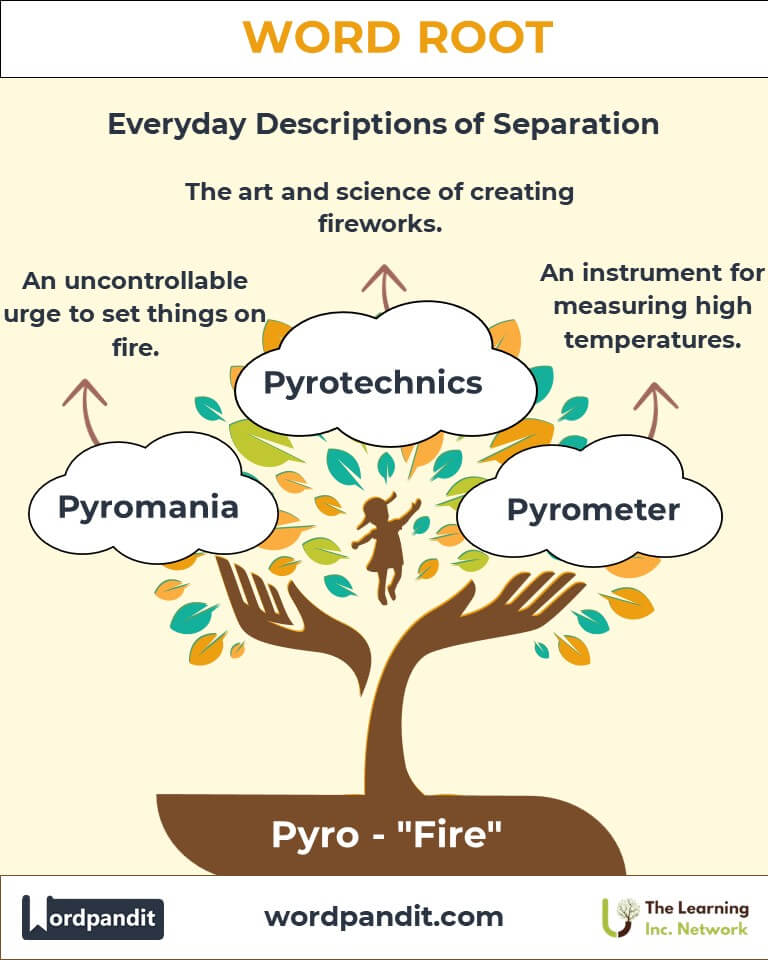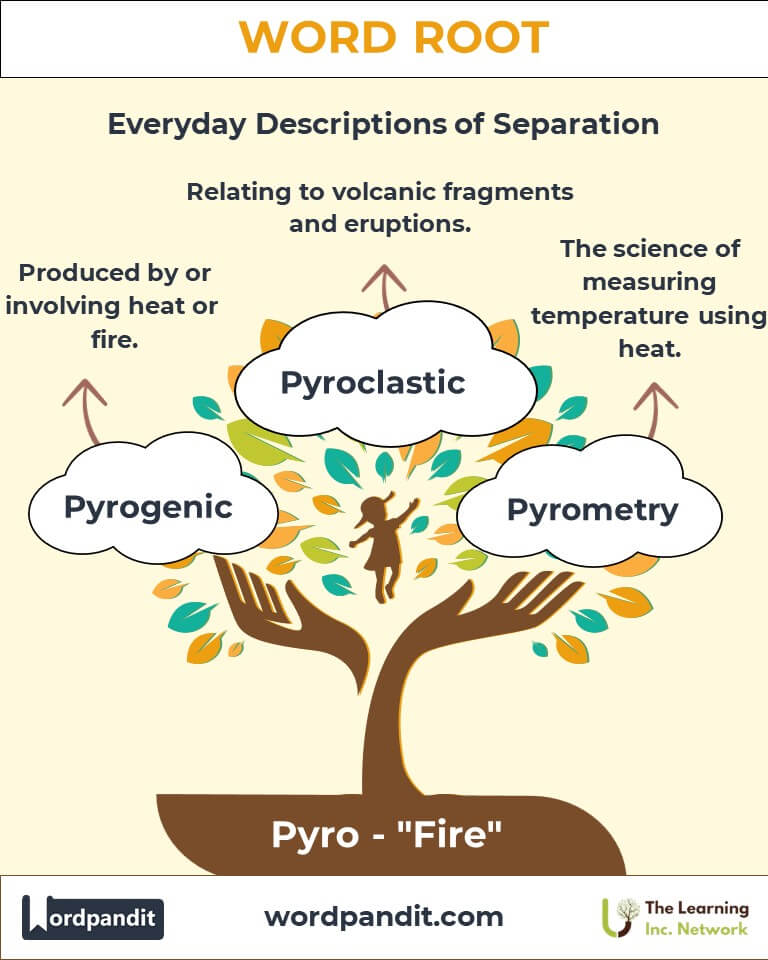Pyro: Igniting Passion Across Languages and Fields
Discover the fiery origins and expansive influence of the root "Pyro," derived from the Greek word for fire. From dazzling pyrotechnics to the psychological intrigue of pyromania, this root illuminates a wide range of meanings, applications, and cultural significance.

Table of Contents
- Introduction: The Fire Within "Pyro"
- Etymology and Historical Journey
- Mnemonic: Unlocking the Power of Pyro
- Common Pyro-Related Terms
- Pyro Through Time
- Pyro in Specialized Fields
- Illustrative Story: Pyro in Action
- Cultural Significance of Pyro
- The Pyro Family Tree
- FAQs about the Pyro Word Root
- Test Your Knowledge: Pyro Mastery Quiz
- Conclusion: The Living Legacy of Pyro
1. Introduction: The Fire Within "Pyro"
The word root "Pyro," pronounced pie-roh, stems from the Greek word pyr, meaning fire. Whether it’s the spectacular display of pyrotechnics or the destructive obsession of pyromania, this root carries the dynamic essence of flames and their ability to transform, destroy, and inspire. From mythology to modern science, "Pyro" has blazed a trail through language, shaping concepts that range from creative artistry to psychological phenomena.

2. Etymology and Historical Journey
"Pyro" originates from the ancient Greek pyr (fire), closely associated with warmth, energy, and transformation. The concept of fire held deep cultural significance, symbolizing creation and destruction in equal measure. In Greek mythology, Prometheus's theft of fire epitomized human ingenuity and defiance.
As language evolved, "Pyro" found its way into Latin, then Old French, and eventually English, branching into scientific, artistic, and psychological vocabularies. The Renaissance saw the term flourish in alchemical studies and theatrical expressions, paving the way for its modern usage in chemistry and entertainment.
3. Mnemonic: Unlocking the Power of Pyro
To remember "Pyro," envision a dazzling fireworks display, each explosion embodying the energy and brilliance of fire.
Mnemonic Device: "Pyro sparks excitement and creativity, igniting the imagination like fireworks in the sky!"
4. Common Pyro-Related Terms
- Pyrotechnics (pie-roh-tek-niks): The art and science of creating fireworks. Example: "The pyrotechnics at the New Year’s celebration were breathtaking."
- Pyromania (pie-roh-may-nee-uh): An uncontrollable urge to set things on fire. Example: "The investigator suspected the blaze was caused by someone with pyromania."
- Pyrometer (pie-rom-uh-ter): An instrument for measuring high temperatures. Example: "The blacksmith used a pyrometer to ensure the metal reached the right temperature."
- Pyroclastic (pie-roh-klas-tik): Relating to volcanic fragments and eruptions. Example: "The pyroclastic flow destroyed everything in its path."
- Pyrogenic (pie-roh-jen-ik): Produced by or involving heat or fire. Example: "Pyrogenic reactions are common in industrial processes."
5. Pyro Through Time
Alchemy and Fire Worship (Medieval Period): The root "Pyro" became central to alchemical practices, symbolizing transformation and purification through fire.
Modern Chemistry: Words like pyrogenic evolved to describe heat-related reactions in industrial and scientific contexts.
Entertainment: The 19th century saw the rise of pyrotechnics as a form of celebratory and theatrical artistry.
6. Pyro in Specialized Fields
- Entertainment: Pyrotechnics involves creating visually captivating fireworks displays. Application: Used in concerts, festivals, and films to enhance visual storytelling.
- Psychology: Pyromania is classified as an impulse-control disorder. Relevance: Understanding pyromania aids in preventing fire-related crimes.
- Geology and Volcanology: Pyroclastic flows are studied to understand volcanic activity and mitigate risks. Significance: Key to volcanic disaster preparedness.
- Engineering: Pyrometers measure temperatures in high-heat environments. Use: Crucial in metallurgy and material sciences.
7. Illustrative Story: Pyro in Action
As a pyrotechnician, Max spent months designing the fireworks display for a city’s Independence Day celebration. Using precision and artistry, he choreographed an intricate sequence of explosions that lit up the night sky. Meanwhile, scientists studied the pyroclastic flow of a nearby volcano, ensuring the safety of residents. In a distant city, a psychologist worked with a patient struggling with pyromania, channeling their fascination with fire into creative outlets like glassblowing. Each story revealed the multifaceted influence of "Pyro."
8. Cultural Significance of Pyro
Fire holds symbolic significance in virtually every culture, often representing life, passion, and transformation. In Hinduism, fire ceremonies (yajnas) honor the divine. In the West, pyrotechnics enhance celebrations, from New Year’s Eve to the Fourth of July. The root "Pyro" thus embodies humanity's enduring relationship with fire, both as a destructive force and a source of wonder.

9. The Pyro Family Tree
- Ignis (Latin: "fire"):
- Ignition: The process of setting something on fire.
- Flam (Latin: "flame"):
- Flammable: Easily set on fire.
- Therm (Greek: "heat"):
- Thermodynamics: The study of heat and energy transfer.

FAQs About the Pyro Word Root
Q: What does "Pyro" mean?
A: "Pyro" means "fire" and originates from the Greek root "pyr." It describes phenomena or objects related to fire, heat, and combustion, appearing in words like "pyrotechnics" (fireworks) and "pyromania" (obsession with fire).
Q: How is "Pyro" used in psychology?
A: In psychology, "Pyro" appears in terms like "pyromania," which refers to a compulsive desire to set fires. Pyromania is classified as an impulse-control disorder and is distinct from arson, as it stems from psychological compulsion rather than intent to cause harm or profit.
Q: What are pyroclastic flows?
A: Pyroclastic flows are fast-moving currents of hot gas, ash, and volcanic debris. They occur during volcanic eruptions and are highly destructive, capable of reaching speeds up to 700 km/h and temperatures of 1,000°C. Understanding pyroclastic flows is crucial for volcanic disaster preparedness.
Q: What does "Pyrotechnics" mean?
A: "Pyrotechnics" combines the Greek words "pyr" (fire) and "technē" (art or skill), referring to the craft of creating controlled explosions, like fireworks. It is widely used in celebrations, theatrical effects, and military displays.
Q: How is "Pyro" applied in engineering?
A: In engineering, "Pyro" appears in terms like "pyrometer," an instrument for measuring high temperatures. Pyrometers are essential in industries like metallurgy and ceramics, where precise temperature control is crucial for processes like forging metals or firing pottery.
Test Your Knowledge: Pyro Word Root Quiz
1. What does "Pyro" mean?
2. Which field uses pyrometers?
3. What is pyromania?
4. What are pyroclastic flows associated with?
5. What does "Pyrotechnics" combine?
12. Conclusion: The Living Legacy of Pyro
The root "Pyro" embodies the dynamic nature of fire—its power to destroy, create, and inspire. From dazzling pyrotechnic displays to critical scientific tools like pyrometers, this root illuminates humanity’s fascination with fire. As language evolves, "Pyro" continues to blaze a trail through disciplines, reminding us of the transformative energy at the heart of life. Let "Pyro" spark your curiosity and appreciation for the fiery forces that shape our world.












